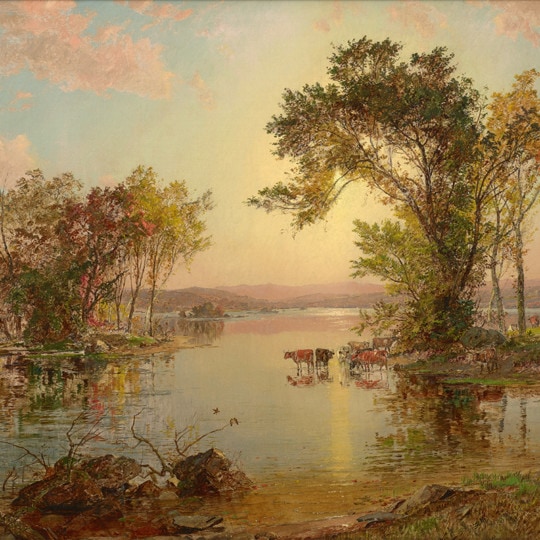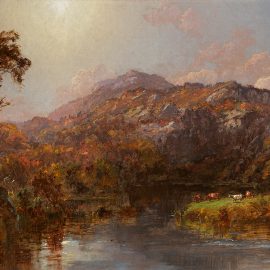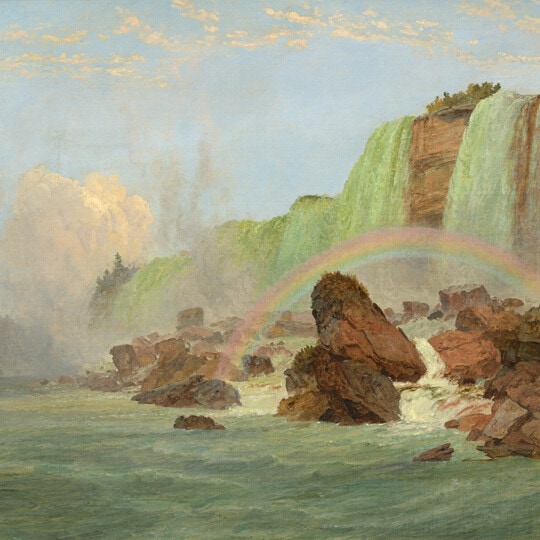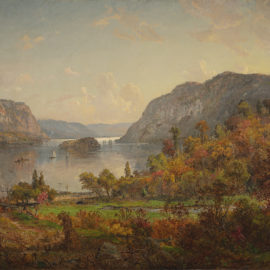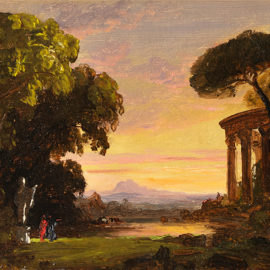Artist Biography
Famed Hudson River School painter and architect.
By Tiffany Win
A leader of the Hudson River School famous for colorful autumnal landscapes.
I. Biography
II. Chronology
III. Collections
IV. Exhibitions
V. Memberships
VI. Notes
VII. Suggested Resources
I. Biography
Jasper Francis Cropsey was born on February 18, 1823 in Rossville, Staten Island, New York. Known to family and friends as “Frank,” the young boy worked on the farm in the summer and attended school in the winter. Growing up in a rural environment meant the artist had little to no exposure to pictures or art. From his youth, he was weak-bodied and suffered illnesses which kept him from full year schooling.
Famed Hudson River School painter and architect.
By Tiffany Win
A leader of the Hudson River School famous for colorful autumnal landscapes.
I. Biography
II. Chronology
III. Collections
IV. Exhibitions
V. Memberships
VI. Notes
VII. Suggested Resources
I. Biography
Jasper Francis Cropsey was born on February 18, 1823 in Rossville, Staten Island, New York. Known to family and friends as “Frank,” the young boy worked on the farm in the summer and attended school in the winter. Growing up in a rural environment meant the artist had little to no exposure to pictures or art. From his youth, he was weak-bodied and suffered illnesses which kept him from full year schooling. He may have taken up drawing to pass the time, and the margins of his notes are littered with sketches of landscape and architecture. He received his diploma in 1837 from the Mechanics Institute of the City of New York, and soon after entered a five year apprenticeship in Joseph Trench’s architectural office in New York. Cropsey’s employer encouraged him to venture into watercolor and oil by giving him supplies and providing his private office as a studio before and after work.
Cropsey left Trench’s office in 1842 and continued to complete architectural commissions, such as two churches. Upon completion of the projects in 1843, Cropsey used the funds for a two week sketching trip to New Jersey and Greenwood Lake, a subject which would reappear in his body of work for many years. His earliest known work is a wash drawing of Greenwood Lake entitled The Nameless River (1843, Cleveland Museum of Art) which was the basis for an oil painting of 1845, View of Greenwood Lake, New Jersey (M.H. de Young Memorial Museum, San Francisco, California).
Cropsey’s dedication to nature was evident in his painitngs as well as his proclamation in an 1845 essay for the New York Art Union entitled “Natural Art,” in which he notes nature’s “great power” and describes that the best poetry and paintings are “their nearest approaches to nature.”[1] Cropsey also gave the piece of advice to study from nature to the young painter George Inness. His own precise observation of nature frequently led to fine topographical drawings which then found their way into his paintings, both in landscapes and a few allegorical pieces as well.
Upon his marriage to Maria Cooley in May 1847, the two embarked on a two year long honeymoon and artistic tour of England and Italy, an important tradition for American landscape painters who wished to see and draw famous historical landmarks. Cropsey’s faithfulness to nature led to rave reviews of his pictures featured in the National Academy’s exhibition in the same year, and critics were confident that he could avoid the corrupting influence of foreign styles after his trip. Cropsey’s mission was to represent a landscape in a style commensurate with its uniqueness fueled by a love of American nature.
Cropsey’s landscapes demonstrate his interest in the particular effects of atmosphere, weather, and cloud formations and his desire to capture both the visual and affective qualities of the changing seasons. The undisputed beauty and infinite variety of natural scenes in America inspired Cropsey and other Hudson River School artists of his generation to observe it closely, explore, make sketches, and ultimately, canonize it in large-scale paintings.[2]
His primary attention throughout his career was directed at native landscapes, and his frequent sketching trips attest to his industry in gathering materials; dated drawings from 1852 indicated that his travels during the summer months ranged from the Hudson Valley through central New York State to Niagara Falls, and to central Vermont and the White Mountains of northern New Hampshire. Winters, on the other hand, were spent in New York where Cropsey shared studio space with Thomas Hicks. Previous to his marriage, Cropsey taught drawing classes to artists such as David Johnson and Norton Bush.
Hoping to enhance his reputation further, Cropsey decided to set sail for England, where he stayed from 1856 to 1863. His friends there included John Ruskin and Daniel Huntington. Cropsey immediately began to draw the English countryside upon his arrival to London. However, because of the high demand for American scenes, Cropsey was commissioned to supply the lithographic firm of Gambert and Co. with a series of sixteen American views to be published in American Scenery, among them Summer, Lake Ontario (1856, private collection) and Autumn on the Delaware.
His largest known work to date is Autumn – On the Hudson River (1860, National Gallery of Art), which he may have begun two years prior to completion. One of his most successful pieces, the work received more attention than any of his pictures exhibited at an institution; the picture was eventually exhibited at the 1862 London Exhibition of the Industry of All Nations at which Cropsey was given a gold medal to be one of the American commissioners.[3] For Cropsey, the joyous palette of autumn color as artistic subject outweighed any moral symbolism which deemed autumn a prophet of lifeless winter. Because of its success in England, Cropsey repeated similar compositions upon his return to the States, refining his palette to create softer, more lyrical atmospheric haze. Cropsey began to frequently produce sharply drawn autumn landscapes, with lively and warm colors and subtleties in the treatment of water and details. His paint is richly and spontaneously handled, creating an open textured surface.
At the same time that he was painting soft atmospheric effects, Cropsey was also doing landscape views with an acuity of vision which strained at human means in depicting
individual details at a great distance. As Cropsey became more interested in the effects of atmosphere and sunlight, he also began to give special attention to sunrise and sunset, producing romantic interpretations of wilderness. His best known work is Old Mill (1879, Amherst College), which exhibited at the international exhibition of 1876 for America’s centennial, held in Philadelphia.[4]
Cropsey returned to architecture in 1863, mostly completing commissions for houses and street elevations. His best known designs were for the passenger stations of the Gilbert Elevated Railway along Sixth Avenue in New York, and upon purchasing 45 acres of land in Warwick, New York, he proceeded to build his Victorian mansion called Aladdin. By 1879, Cropsey was in dire financial straits due the scale of the project and the declining American art market, and unfortunately it had to be mortgaged in 1884. By June 1885, Cropsey and his family relocated to Hastings-on-Hudson. In later years, due to his failing health, Cropsey turned to watercolors, becoming a founding member of the American Water Color Society and continuously contributing to its annual exhibitions. After suffering a mild stroke in 1891, Cropsey’s works became smaller and of familiar subjects, glowing with the nostalgic serenity of a past age when a vista of American rivers, lakes, and mountains was both a religious and national symbol.
Cropsey’s vigorous drawing and bright palette distinguish him from many of his own generation. He inherited Thomas Cole’s interest in American autumn scenes yet developed brilliant paintings much closer to actuality in coloristic intensity than those of Cole. Cropsey died in 1900 of old age in his home in Hastings-on-Hudson.
II. Chronology
1823 Born on February 18th in Rossville, Staten Island
1837 Won diploma at the Mechanics’ Institute Fair for his model of a country house
1837–1842 Worked as an apprentice in Joseph Trench’s office, studied watercolor with Edward Maury, made first oil paintings, using Trench’s office as a studio
1843 Exhibited for the first time at the National Academy of Design (Landscape Composition, 1843), established own architectural practice in New York, designed a house and two churches, visited Greenwood Lake, New Jersey, in autumn
1844 Elected an Associate of the National Academy of Design for View in Orange County With Greenwood Lake In The Distance, 1844
1845 Wrote essay “Natural Art” for the Art Union, summered in Connecticut where he met George Inness
1847 Married Maria Cooley, sailed for England, arrived in Italy in September, settled in Thomas Cole’s former studio in Rome
1848 Summered at the coast of southern Italy
1849 Returned to the United States
1850 Gave art lessons
1851 Elected an Academician by the National Academy of Design, became interested in literary and allegorical paintings, executed Spirit of War and Spirit of Peace
1852–1855 Went on sketching trips to the White Mountains, Niagara Falls, Canada, and Michigan
1854 Visited Newport, elected Honorary Professional member of Pennsylvania Academy of the Fine Arts
1856 Sailed for England, established a studio there, befriended John Ruskin, Daniel Huntington, and Sir Charles Eastlake
1862 Appointed to the American Commission of the London Exposition and received a medal from Queen Victoria for his services
1863 Returned to New York, visited Gettysburg to witness the aftermath of the Civil War, resumed architectural practice
1867 Became one of the founders of the American Water Color Society
1869 Completed construction of his home and studio, Aladdin, near Warwick, NY, began to summer there and winter in New York
1878 Designed passenger stations for the Gilbert Elevated Railway in New York
1879 Designed the decorations for the drill room of the Seventh Regiment Armory in New York
1885 Sold Aladdin, bought home in Hastings-on-Hudson, NY and added a studio, named it Ever Rest
1885–1900 Painted mainly Hudson River scenes and worked increasingly in watercolor, continued to exhibit at the National Academy of Design and the American Water Color Society
1900 Died on June 22nd at Ever Rest
III. Collections
Addison Gallery of American Art, MA
Albany Institute of History and Art, NY
Allen Art Museum, OH
Bowdoin College Museum of Art, ME
Brigham Young University Museum of Art, UT
Art Institute of Chicago, IL
Butler Institute of American Art, OH
Detroit Institute of Arts, MI
Brooklyn Museum of Art, NY
Canton Museum of Art, OH
Carnegie Museum of Art, PA
Chrysler Museum, VA
Cleveland Museum of Art, OH
Corcoran Gallery of Art, Washington DC
Currier Gallery of Art, NH
Hudson River Museum, NY
Indianapolis Museum of Art, IN
Joslyn Art Museum, NE
Los Angeles County Museum of Art, CA
Mattatuck Museum, CT
Minneapolis Institute of Arts, MN
Museum of the City of New York, NY
Museum of the National Academy of Design, NY
North Carolina Museum of Art, NC
Museum of Fine Arts, Boston, MA
Muesum of Fine Arts, TX
National Gallery of Art, Washington DC
Newington Cropsey Foundation, NY
Pennsylvania Academy of the Fine Arts, PA
Princeton University Art Museum, NJ
Reynolda House Museum of American Art, NC
Samuel Dorsky Museum of Art, NY
Sheldon Museum of Art, NE
Smithsonian American Art Museum, Washington DC
St. Johnsbury Athenaeum, VT
Newark Museum, NJ
Thyssen-Bornemisza Museum, Madrid, Spain
Timken Museum of Art, CA
The Metropolitan Museum of Art, NY
Toleda Museum of Art, OH
Virginia Museum of Fine Arts, VA
Westmoreland Museum of American Art, PA
Wichita Art Museum, KS
IV. Exhibitions
1843 National Academy of Design
1853 Industry of All Nations
1862 London Exhibition of the Industry of All Nations
1867 Universal Exposition in Paris
1876 Centennial Exposition in Philadelphia
1881–86 Boston Art Club
1897 Art Institute of Chicago
V. Memberships
American Water Color Society, founding member
Artists’ Aid Society
Artists’ Fund Society
Century Club
Lotos Club
National Academy of Design
Pennsylvania Academy of the Fine Arts
Union League Club, founding member
VI. Suggested Resources
1. Falk, Peter H. Who was who in American art: compiled from the original thirty-four volumes of American art annual--Who's who in art, biographies of American artists active from 1898–1947. Madison, Conn.: Sound View Press, 1985.
2. Foshay, Ella M., Barbara Finney, Mishoe Brennecke. Jasper F. Cropsey: Artist and Architect. New York: New-York Historical Society, 1987.
3. Talbot, William S. Jasper F. Cropsey 1823–1900. Washington, DC: Smithsonian Institution Press, 1970.
VII. Notes
1. William S. Talbot, Jasper F. Cropsey 1823–1900 (Washington, DC: Smithsonian Insitution Press, 1970), 17.
2. Ella M. Foshay, Barbara Finney, Mishoe Brennecke, Jasper F. Cropsey: Artist and Architect (New York: New-York Historical Society, 1987), 26.
3. Talbot, 86.
4. Ibid, 38.
Famed Hudson River School painter and architect.
By Tiffany Win
A leader of the Hudson River School famous for colorful autumnal landscapes.
I. Biography
II. Chronology
III. Collections
IV. Exhibitions
V. Memberships
VI. Notes
VII. Suggested Resources
I. Biography
Jasper Francis Cropsey was born on February 18, 1823 in Rossville, Staten Island, New York. Known to family and friends as “Frank,” the young boy worked on the farm in the summer and attended school in the winter. Growing up in a rural environment meant the artist had little to no exposure to pictures or art. From his youth, he was weak-bodied and suffered illnesses which kept him from full year schooling. He may have taken up drawing to pass the time, and the margins of his notes are littered with sketches of landscape and architecture. He received his diploma in 1837 from the Mechanics Institute of the City of New York, and soon after entered a five year apprenticeship in Joseph Trench’s architectural office in New York. Cropsey’s employer encouraged him to venture into watercolor and oil by giving him supplies and providing his private office as a studio before and after work.
Cropsey left Trench’s office in 1842 and continued to complete architectural commissions, such as two churches. Upon completion of the projects in 1843, Cropsey used the funds for a two week sketching trip to New Jersey and Greenwood Lake, a subject which would reappear in his body of work for many years. His earliest known work is a wash drawing of Greenwood Lake entitled The Nameless River (1843, Cleveland Museum of Art) which was the basis for an oil painting of 1845, View of Greenwood Lake, New Jersey (M.H. de Young Memorial Museum, San Francisco, California).
Cropsey’s dedication to nature was evident in his painitngs as well as his proclamation in an 1845 essay for the New York Art Union entitled “Natural Art,” in which he notes nature’s “great power” and describes that the best poetry and paintings are “their nearest approaches to nature.”[1] Cropsey also gave the piece of advice to study from nature to the young painter George Inness. His own precise observation of nature frequently led to fine topographical drawings which then found their way into his paintings, both in landscapes and a few allegorical pieces as well.
Upon his marriage to Maria Cooley in May 1847, the two embarked on a two year long honeymoon and artistic tour of England and Italy, an important tradition for American landscape painters who wished to see and draw famous historical landmarks. Cropsey’s faithfulness to nature led to rave reviews of his pictures featured in the National Academy’s exhibition in the same year, and critics were confident that he could avoid the corrupting influence of foreign styles after his trip. Cropsey’s mission was to represent a landscape in a style commensurate with its uniqueness fueled by a love of American nature.
Cropsey’s landscapes demonstrate his interest in the particular effects of atmosphere, weather, and cloud formations and his desire to capture both the visual and affective qualities of the changing seasons. The undisputed beauty and infinite variety of natural scenes in America inspired Cropsey and other Hudson River School artists of his generation to observe it closely, explore, make sketches, and ultimately, canonize it in large-scale paintings.[2]
His primary attention throughout his career was directed at native landscapes, and his frequent sketching trips attest to his industry in gathering materials; dated drawings from 1852 indicated that his travels during the summer months ranged from the Hudson Valley through central New York State to Niagara Falls, and to central Vermont and the White Mountains of northern New Hampshire. Winters, on the other hand, were spent in New York where Cropsey shared studio space with Thomas Hicks. Previous to his marriage, Cropsey taught drawing classes to artists such as David Johnson and Norton Bush.
Hoping to enhance his reputation further, Cropsey decided to set sail for England, where he stayed from 1856 to 1863. His friends there included John Ruskin and Daniel Huntington. Cropsey immediately began to draw the English countryside upon his arrival to London. However, because of the high demand for American scenes, Cropsey was commissioned to supply the lithographic firm of Gambert and Co. with a series of sixteen American views to be published in American Scenery, among them Summer, Lake Ontario (1856, private collection) and Autumn on the Delaware.
His largest known work to date is Autumn – On the Hudson River (1860, National Gallery of Art), which he may have begun two years prior to completion. One of his most successful pieces, the work received more attention than any of his pictures exhibited at an institution; the picture was eventually exhibited at the 1862 London Exhibition of the Industry of All Nations at which Cropsey was given a gold medal to be one of the American commissioners.[3] For Cropsey, the joyous palette of autumn color as artistic subject outweighed any moral symbolism which deemed autumn a prophet of lifeless winter. Because of its success in England, Cropsey repeated similar compositions upon his return to the States, refining his palette to create softer, more lyrical atmospheric haze. Cropsey began to frequently produce sharply drawn autumn landscapes, with lively and warm colors and subtleties in the treatment of water and details. His paint is richly and spontaneously handled, creating an open textured surface.
At the same time that he was painting soft atmospheric effects, Cropsey was also doing landscape views with an acuity of vision which strained at human means in depicting
individual details at a great distance. As Cropsey became more interested in the effects of atmosphere and sunlight, he also began to give special attention to sunrise and sunset, producing romantic interpretations of wilderness. His best known work is Old Mill (1879, Amherst College), which exhibited at the international exhibition of 1876 for America’s centennial, held in Philadelphia.[4]
Cropsey returned to architecture in 1863, mostly completing commissions for houses and street elevations. His best known designs were for the passenger stations of the Gilbert Elevated Railway along Sixth Avenue in New York, and upon purchasing 45 acres of land in Warwick, New York, he proceeded to build his Victorian mansion called Aladdin. By 1879, Cropsey was in dire financial straits due the scale of the project and the declining American art market, and unfortunately it had to be mortgaged in 1884. By June 1885, Cropsey and his family relocated to Hastings-on-Hudson. In later years, due to his failing health, Cropsey turned to watercolors, becoming a founding member of the American Water Color Society and continuously contributing to its annual exhibitions. After suffering a mild stroke in 1891, Cropsey’s works became smaller and of familiar subjects, glowing with the nostalgic serenity of a past age when a vista of American rivers, lakes, and mountains was both a religious and national symbol.
Cropsey’s vigorous drawing and bright palette distinguish him from many of his own generation. He inherited Thomas Cole’s interest in American autumn scenes yet developed brilliant paintings much closer to actuality in coloristic intensity than those of Cole. Cropsey died in 1900 of old age in his home in Hastings-on-Hudson.
II. Chronology
1823 Born on February 18th in Rossville, Staten Island
1837 Won diploma at the Mechanics’ Institute Fair for his model of a country house
1837–1842 Worked as an apprentice in Joseph Trench’s office, studied watercolor with Edward Maury, made first oil paintings, using Trench’s office as a studio
1843 Exhibited for the first time at the National Academy of Design (Landscape Composition, 1843), established own architectural practice in New York, designed a house and two churches, visited Greenwood Lake, New Jersey, in autumn
1844 Elected an Associate of the National Academy of Design for View in Orange County With Greenwood Lake In The Distance, 1844
1845 Wrote essay “Natural Art” for the Art Union, summered in Connecticut where he met George Inness
1847 Married Maria Cooley, sailed for England, arrived in Italy in September, settled in Thomas Cole’s former studio in Rome
1848 Summered at the coast of southern Italy
1849 Returned to the United States
1850 Gave art lessons
1851 Elected an Academician by the National Academy of Design, became interested in literary and allegorical paintings, executed Spirit of War and Spirit of Peace
1852–1855 Went on sketching trips to the White Mountains, Niagara Falls, Canada, and Michigan
1854 Visited Newport, elected Honorary Professional member of Pennsylvania Academy of the Fine Arts
1856 Sailed for England, established a studio there, befriended John Ruskin, Daniel Huntington, and Sir Charles Eastlake
1862 Appointed to the American Commission of the London Exposition and received a medal from Queen Victoria for his services
1863 Returned to New York, visited Gettysburg to witness the aftermath of the Civil War, resumed architectural practice
1867 Became one of the founders of the American Water Color Society
1869 Completed construction of his home and studio, Aladdin, near Warwick, NY, began to summer there and winter in New York
1878 Designed passenger stations for the Gilbert Elevated Railway in New York
1879 Designed the decorations for the drill room of the Seventh Regiment Armory in New York
1885 Sold Aladdin, bought home in Hastings-on-Hudson, NY and added a studio, named it Ever Rest
1885–1900 Painted mainly Hudson River scenes and worked increasingly in watercolor, continued to exhibit at the National Academy of Design and the American Water Color Society
1900 Died on June 22nd at Ever Rest
III. Collections
Addison Gallery of American Art, MA
Albany Institute of History and Art, NY
Allen Art Museum, OH
Bowdoin College Museum of Art, ME
Brigham Young University Museum of Art, UT
Art Institute of Chicago, IL
Butler Institute of American Art, OH
Detroit Institute of Arts, MI
Brooklyn Museum of Art, NY
Canton Museum of Art, OH
Carnegie Museum of Art, PA
Chrysler Museum, VA
Cleveland Museum of Art, OH
Corcoran Gallery of Art, Washington DC
Currier Gallery of Art, NH
Hudson River Museum, NY
Indianapolis Museum of Art, IN
Joslyn Art Museum, NE
Los Angeles County Museum of Art, CA
Mattatuck Museum, CT
Minneapolis Institute of Arts, MN
Museum of the City of New York, NY
Museum of the National Academy of Design, NY
North Carolina Museum of Art, NC
Museum of Fine Arts, Boston, MA
Muesum of Fine Arts, TX
National Gallery of Art, Washington DC
Newington Cropsey Foundation, NY
Pennsylvania Academy of the Fine Arts, PA
Princeton University Art Museum, NJ
Reynolda House Museum of American Art, NC
Samuel Dorsky Museum of Art, NY
Sheldon Museum of Art, NE
Smithsonian American Art Museum, Washington DC
St. Johnsbury Athenaeum, VT
Newark Museum, NJ
Thyssen-Bornemisza Museum, Madrid, Spain
Timken Museum of Art, CA
The Metropolitan Museum of Art, NY
Toleda Museum of Art, OH
Virginia Museum of Fine Arts, VA
Westmoreland Museum of American Art, PA
Wichita Art Museum, KS
IV. Exhibitions
1843 National Academy of Design
1853 Industry of All Nations
1862 London Exhibition of the Industry of All Nations
1867 Universal Exposition in Paris
1876 Centennial Exposition in Philadelphia
1881–86 Boston Art Club
1897 Art Institute of Chicago
V. Memberships
American Water Color Society, founding member
Artists’ Aid Society
Artists’ Fund Society
Century Club
Lotos Club
National Academy of Design
Pennsylvania Academy of the Fine Arts
Union League Club, founding member
VI. Suggested Resources
1. Falk, Peter H. Who was who in American art: compiled from the original thirty-four volumes of American art annual--Who's who in art, biographies of American artists active from 1898–1947. Madison, Conn.: Sound View Press, 1985.
2. Foshay, Ella M., Barbara Finney, Mishoe Brennecke. Jasper F. Cropsey: Artist and Architect. New York: New-York Historical Society, 1987.
3. Talbot, William S. Jasper F. Cropsey 1823–1900. Washington, DC: Smithsonian Institution Press, 1970.
VII. Notes
1. William S. Talbot, Jasper F. Cropsey 1823–1900 (Washington, DC: Smithsonian Insitution Press, 1970), 17.
2. Ella M. Foshay, Barbara Finney, Mishoe Brennecke, Jasper F. Cropsey: Artist and Architect (New York: New-York Historical Society, 1987), 26.
3. Talbot, 86.
4. Ibid, 38.

